Enhancing Leadership: Storytelling, Trust, and Collaboration
VerifiedAdded on 2020/10/07
|5
|2276
|99
Presentation
AI Summary
This presentation delves into the critical role of storytelling in effective leadership, emphasizing its importance in building trust, fostering collaboration, and enhancing employee engagement. It begins by introducing the subject matter of workflow planning and replacement of a hospital CT machine, and then highlights the importance of storytelling as a leadership tool, analyzing tools such as focusing on the human element and communication. The presentation then transitions into a personal story of the presenter's experience as an imaging supervisor, detailing challenges in obtaining equipment replacement and the strategies employed to overcome obstacles through collaboration, communication, and building trust with employees and other departments. The narrative culminates in a successful outcome, emphasizing the lessons learned about the importance of trust, communication, and collaboration in the workplace. The presentation concludes by connecting the story to the broader subject matter, reiterating the value of storytelling as a means of fostering trust, inspiring confidence, and driving organizational success. The presentation also includes references to support the concepts discussed.
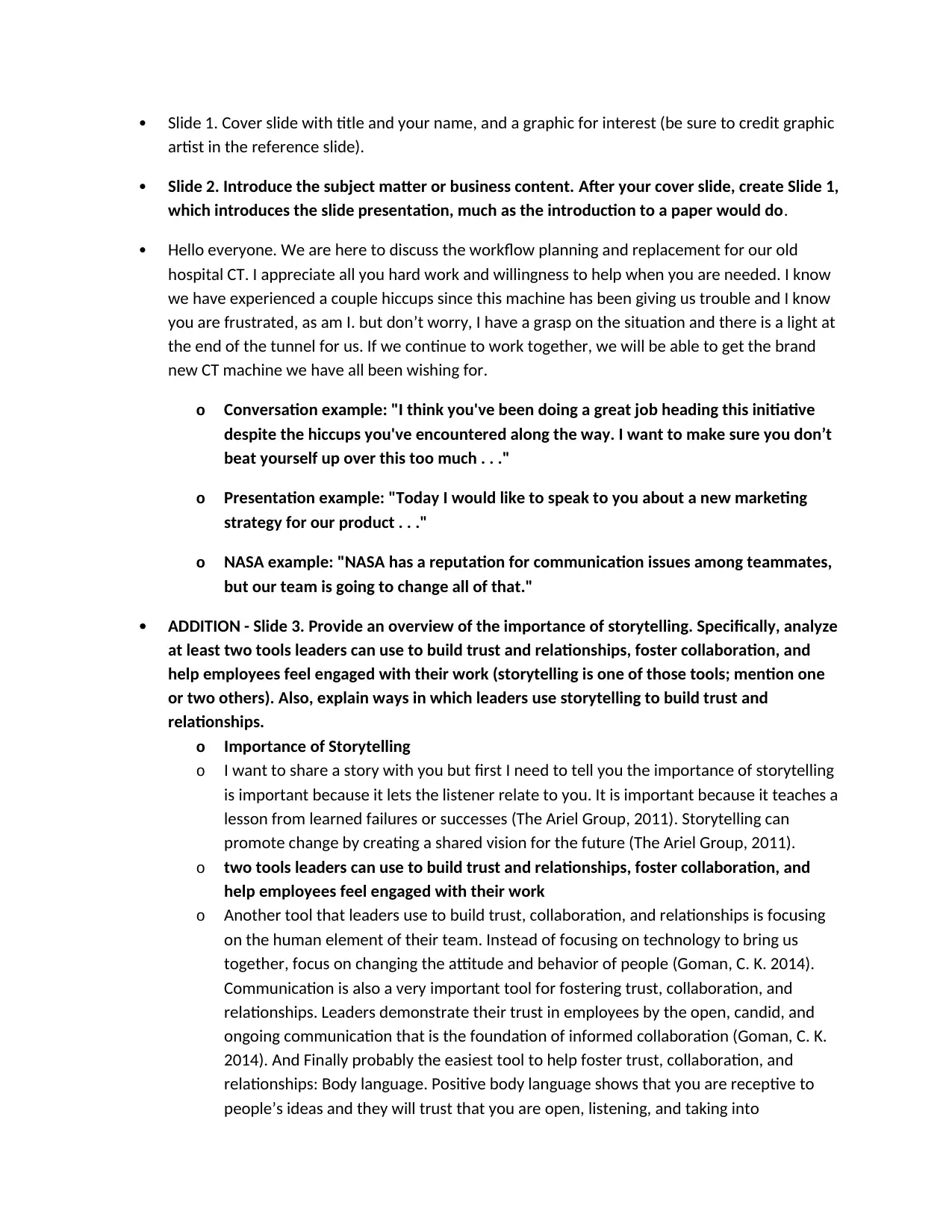
Slide 1. Cover slide with title and your name, and a graphic for interest (be sure to credit graphic
artist in the reference slide).
Slide 2. Introduce the subject matter or business content. After your cover slide, create Slide 1,
which introduces the slide presentation, much as the introduction to a paper would do.
Hello everyone. We are here to discuss the workflow planning and replacement for our old
hospital CT. I appreciate all you hard work and willingness to help when you are needed. I know
we have experienced a couple hiccups since this machine has been giving us trouble and I know
you are frustrated, as am I. but don’t worry, I have a grasp on the situation and there is a light at
the end of the tunnel for us. If we continue to work together, we will be able to get the brand
new CT machine we have all been wishing for.
o Conversation example: "I think you've been doing a great job heading this initiative
despite the hiccups you've encountered along the way. I want to make sure you don’t
beat yourself up over this too much . . ."
o Presentation example: "Today I would like to speak to you about a new marketing
strategy for our product . . ."
o NASA example: "NASA has a reputation for communication issues among teammates,
but our team is going to change all of that."
ADDITION - Slide 3. Provide an overview of the importance of storytelling. Specifically, analyze
at least two tools leaders can use to build trust and relationships, foster collaboration, and
help employees feel engaged with their work (storytelling is one of those tools; mention one
or two others). Also, explain ways in which leaders use storytelling to build trust and
relationships.
o Importance of Storytelling
o I want to share a story with you but first I need to tell you the importance of storytelling
is important because it lets the listener relate to you. It is important because it teaches a
lesson from learned failures or successes (The Ariel Group, 2011). Storytelling can
promote change by creating a shared vision for the future (The Ariel Group, 2011).
o two tools leaders can use to build trust and relationships, foster collaboration, and
help employees feel engaged with their work
o Another tool that leaders use to build trust, collaboration, and relationships is focusing
on the human element of their team. Instead of focusing on technology to bring us
together, focus on changing the attitude and behavior of people (Goman, C. K. 2014).
Communication is also a very important tool for fostering trust, collaboration, and
relationships. Leaders demonstrate their trust in employees by the open, candid, and
ongoing communication that is the foundation of informed collaboration (Goman, C. K.
2014). And Finally probably the easiest tool to help foster trust, collaboration, and
relationships: Body language. Positive body language shows that you are receptive to
people’s ideas and they will trust that you are open, listening, and taking into
artist in the reference slide).
Slide 2. Introduce the subject matter or business content. After your cover slide, create Slide 1,
which introduces the slide presentation, much as the introduction to a paper would do.
Hello everyone. We are here to discuss the workflow planning and replacement for our old
hospital CT. I appreciate all you hard work and willingness to help when you are needed. I know
we have experienced a couple hiccups since this machine has been giving us trouble and I know
you are frustrated, as am I. but don’t worry, I have a grasp on the situation and there is a light at
the end of the tunnel for us. If we continue to work together, we will be able to get the brand
new CT machine we have all been wishing for.
o Conversation example: "I think you've been doing a great job heading this initiative
despite the hiccups you've encountered along the way. I want to make sure you don’t
beat yourself up over this too much . . ."
o Presentation example: "Today I would like to speak to you about a new marketing
strategy for our product . . ."
o NASA example: "NASA has a reputation for communication issues among teammates,
but our team is going to change all of that."
ADDITION - Slide 3. Provide an overview of the importance of storytelling. Specifically, analyze
at least two tools leaders can use to build trust and relationships, foster collaboration, and
help employees feel engaged with their work (storytelling is one of those tools; mention one
or two others). Also, explain ways in which leaders use storytelling to build trust and
relationships.
o Importance of Storytelling
o I want to share a story with you but first I need to tell you the importance of storytelling
is important because it lets the listener relate to you. It is important because it teaches a
lesson from learned failures or successes (The Ariel Group, 2011). Storytelling can
promote change by creating a shared vision for the future (The Ariel Group, 2011).
o two tools leaders can use to build trust and relationships, foster collaboration, and
help employees feel engaged with their work
o Another tool that leaders use to build trust, collaboration, and relationships is focusing
on the human element of their team. Instead of focusing on technology to bring us
together, focus on changing the attitude and behavior of people (Goman, C. K. 2014).
Communication is also a very important tool for fostering trust, collaboration, and
relationships. Leaders demonstrate their trust in employees by the open, candid, and
ongoing communication that is the foundation of informed collaboration (Goman, C. K.
2014). And Finally probably the easiest tool to help foster trust, collaboration, and
relationships: Body language. Positive body language shows that you are receptive to
people’s ideas and they will trust that you are open, listening, and taking into
Paraphrase This Document
Need a fresh take? Get an instant paraphrase of this document with our AI Paraphraser
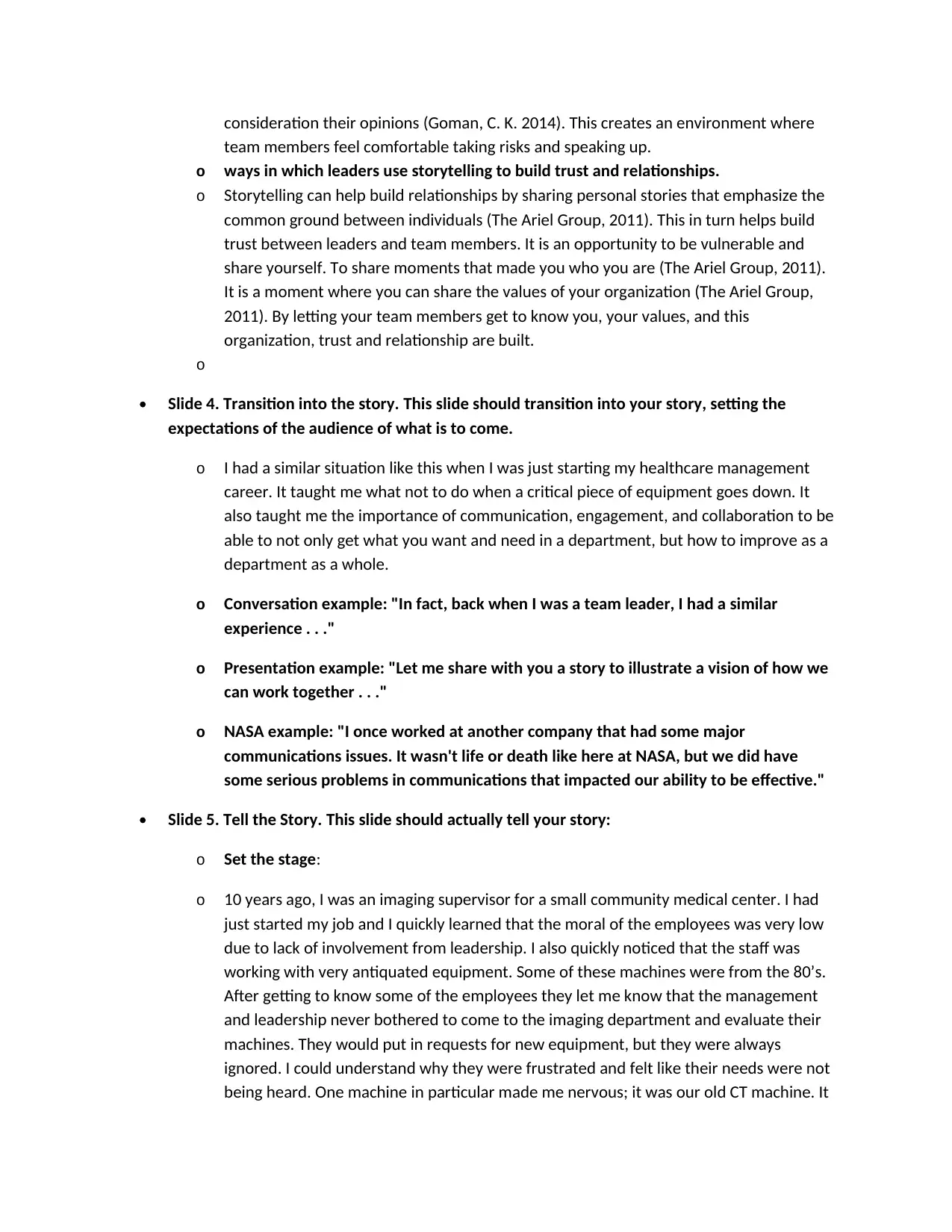
consideration their opinions (Goman, C. K. 2014). This creates an environment where
team members feel comfortable taking risks and speaking up.
o ways in which leaders use storytelling to build trust and relationships.
o Storytelling can help build relationships by sharing personal stories that emphasize the
common ground between individuals (The Ariel Group, 2011). This in turn helps build
trust between leaders and team members. It is an opportunity to be vulnerable and
share yourself. To share moments that made you who you are (The Ariel Group, 2011).
It is a moment where you can share the values of your organization (The Ariel Group,
2011). By letting your team members get to know you, your values, and this
organization, trust and relationship are built.
o
Slide 4. Transition into the story. This slide should transition into your story, setting the
expectations of the audience of what is to come.
o I had a similar situation like this when I was just starting my healthcare management
career. It taught me what not to do when a critical piece of equipment goes down. It
also taught me the importance of communication, engagement, and collaboration to be
able to not only get what you want and need in a department, but how to improve as a
department as a whole.
o Conversation example: "In fact, back when I was a team leader, I had a similar
experience . . ."
o Presentation example: "Let me share with you a story to illustrate a vision of how we
can work together . . ."
o NASA example: "I once worked at another company that had some major
communications issues. It wasn't life or death like here at NASA, but we did have
some serious problems in communications that impacted our ability to be effective."
Slide 5. Tell the Story. This slide should actually tell your story:
o Set the stage:
o 10 years ago, I was an imaging supervisor for a small community medical center. I had
just started my job and I quickly learned that the moral of the employees was very low
due to lack of involvement from leadership. I also quickly noticed that the staff was
working with very antiquated equipment. Some of these machines were from the 80’s.
After getting to know some of the employees they let me know that the management
and leadership never bothered to come to the imaging department and evaluate their
machines. They would put in requests for new equipment, but they were always
ignored. I could understand why they were frustrated and felt like their needs were not
being heard. One machine in particular made me nervous; it was our old CT machine. It
team members feel comfortable taking risks and speaking up.
o ways in which leaders use storytelling to build trust and relationships.
o Storytelling can help build relationships by sharing personal stories that emphasize the
common ground between individuals (The Ariel Group, 2011). This in turn helps build
trust between leaders and team members. It is an opportunity to be vulnerable and
share yourself. To share moments that made you who you are (The Ariel Group, 2011).
It is a moment where you can share the values of your organization (The Ariel Group,
2011). By letting your team members get to know you, your values, and this
organization, trust and relationship are built.
o
Slide 4. Transition into the story. This slide should transition into your story, setting the
expectations of the audience of what is to come.
o I had a similar situation like this when I was just starting my healthcare management
career. It taught me what not to do when a critical piece of equipment goes down. It
also taught me the importance of communication, engagement, and collaboration to be
able to not only get what you want and need in a department, but how to improve as a
department as a whole.
o Conversation example: "In fact, back when I was a team leader, I had a similar
experience . . ."
o Presentation example: "Let me share with you a story to illustrate a vision of how we
can work together . . ."
o NASA example: "I once worked at another company that had some major
communications issues. It wasn't life or death like here at NASA, but we did have
some serious problems in communications that impacted our ability to be effective."
Slide 5. Tell the Story. This slide should actually tell your story:
o Set the stage:
o 10 years ago, I was an imaging supervisor for a small community medical center. I had
just started my job and I quickly learned that the moral of the employees was very low
due to lack of involvement from leadership. I also quickly noticed that the staff was
working with very antiquated equipment. Some of these machines were from the 80’s.
After getting to know some of the employees they let me know that the management
and leadership never bothered to come to the imaging department and evaluate their
machines. They would put in requests for new equipment, but they were always
ignored. I could understand why they were frustrated and felt like their needs were not
being heard. One machine in particular made me nervous; it was our old CT machine. It
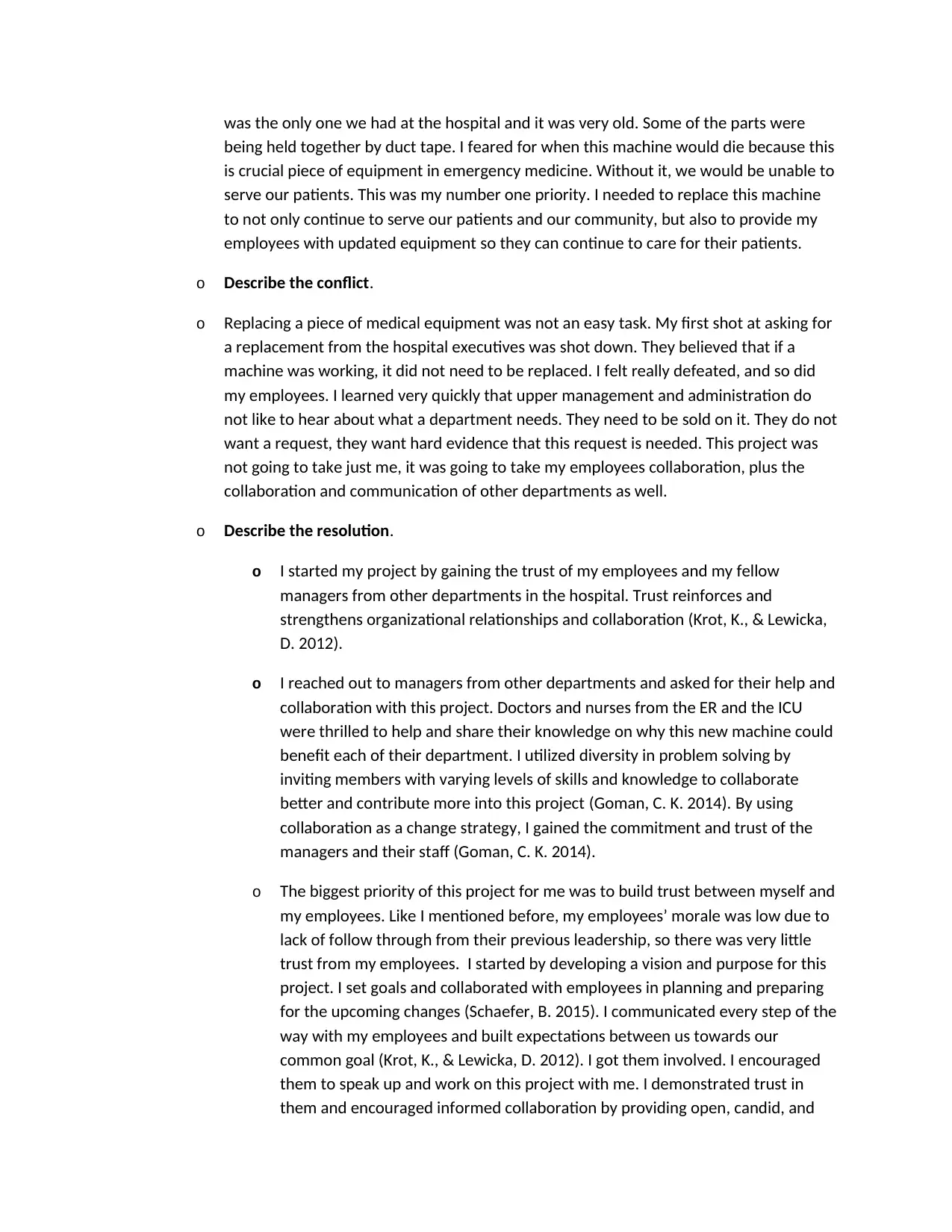
was the only one we had at the hospital and it was very old. Some of the parts were
being held together by duct tape. I feared for when this machine would die because this
is crucial piece of equipment in emergency medicine. Without it, we would be unable to
serve our patients. This was my number one priority. I needed to replace this machine
to not only continue to serve our patients and our community, but also to provide my
employees with updated equipment so they can continue to care for their patients.
o Describe the conflict.
o Replacing a piece of medical equipment was not an easy task. My first shot at asking for
a replacement from the hospital executives was shot down. They believed that if a
machine was working, it did not need to be replaced. I felt really defeated, and so did
my employees. I learned very quickly that upper management and administration do
not like to hear about what a department needs. They need to be sold on it. They do not
want a request, they want hard evidence that this request is needed. This project was
not going to take just me, it was going to take my employees collaboration, plus the
collaboration and communication of other departments as well.
o Describe the resolution.
o I started my project by gaining the trust of my employees and my fellow
managers from other departments in the hospital. Trust reinforces and
strengthens organizational relationships and collaboration (Krot, K., & Lewicka,
D. 2012).
o I reached out to managers from other departments and asked for their help and
collaboration with this project. Doctors and nurses from the ER and the ICU
were thrilled to help and share their knowledge on why this new machine could
benefit each of their department. I utilized diversity in problem solving by
inviting members with varying levels of skills and knowledge to collaborate
better and contribute more into this project (Goman, C. K. 2014). By using
collaboration as a change strategy, I gained the commitment and trust of the
managers and their staff (Goman, C. K. 2014).
o The biggest priority of this project for me was to build trust between myself and
my employees. Like I mentioned before, my employees’ morale was low due to
lack of follow through from their previous leadership, so there was very little
trust from my employees. I started by developing a vision and purpose for this
project. I set goals and collaborated with employees in planning and preparing
for the upcoming changes (Schaefer, B. 2015). I communicated every step of the
way with my employees and built expectations between us towards our
common goal (Krot, K., & Lewicka, D. 2012). I got them involved. I encouraged
them to speak up and work on this project with me. I demonstrated trust in
them and encouraged informed collaboration by providing open, candid, and
being held together by duct tape. I feared for when this machine would die because this
is crucial piece of equipment in emergency medicine. Without it, we would be unable to
serve our patients. This was my number one priority. I needed to replace this machine
to not only continue to serve our patients and our community, but also to provide my
employees with updated equipment so they can continue to care for their patients.
o Describe the conflict.
o Replacing a piece of medical equipment was not an easy task. My first shot at asking for
a replacement from the hospital executives was shot down. They believed that if a
machine was working, it did not need to be replaced. I felt really defeated, and so did
my employees. I learned very quickly that upper management and administration do
not like to hear about what a department needs. They need to be sold on it. They do not
want a request, they want hard evidence that this request is needed. This project was
not going to take just me, it was going to take my employees collaboration, plus the
collaboration and communication of other departments as well.
o Describe the resolution.
o I started my project by gaining the trust of my employees and my fellow
managers from other departments in the hospital. Trust reinforces and
strengthens organizational relationships and collaboration (Krot, K., & Lewicka,
D. 2012).
o I reached out to managers from other departments and asked for their help and
collaboration with this project. Doctors and nurses from the ER and the ICU
were thrilled to help and share their knowledge on why this new machine could
benefit each of their department. I utilized diversity in problem solving by
inviting members with varying levels of skills and knowledge to collaborate
better and contribute more into this project (Goman, C. K. 2014). By using
collaboration as a change strategy, I gained the commitment and trust of the
managers and their staff (Goman, C. K. 2014).
o The biggest priority of this project for me was to build trust between myself and
my employees. Like I mentioned before, my employees’ morale was low due to
lack of follow through from their previous leadership, so there was very little
trust from my employees. I started by developing a vision and purpose for this
project. I set goals and collaborated with employees in planning and preparing
for the upcoming changes (Schaefer, B. 2015). I communicated every step of the
way with my employees and built expectations between us towards our
common goal (Krot, K., & Lewicka, D. 2012). I got them involved. I encouraged
them to speak up and work on this project with me. I demonstrated trust in
them and encouraged informed collaboration by providing open, candid, and
⊘ This is a preview!⊘
Do you want full access?
Subscribe today to unlock all pages.

Trusted by 1+ million students worldwide
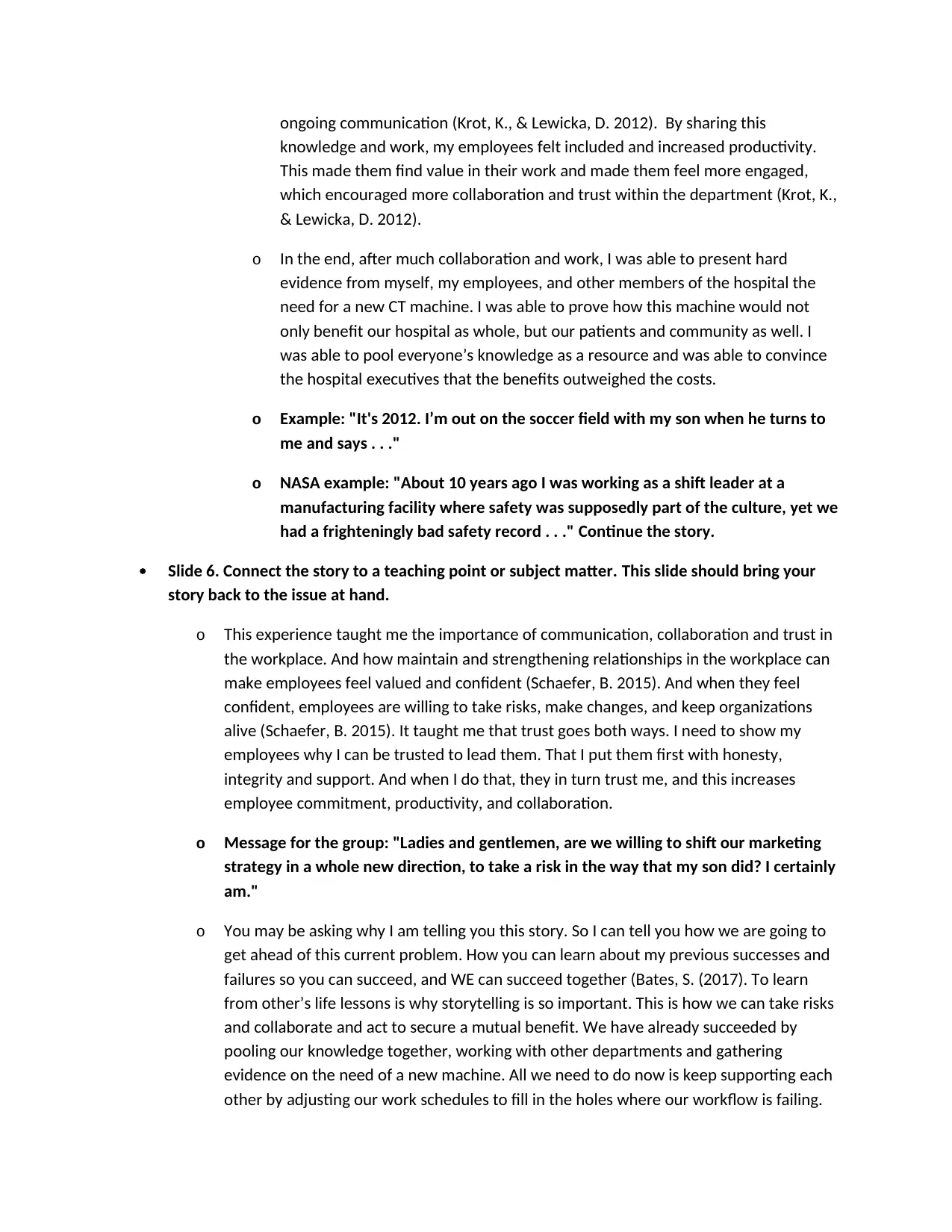
ongoing communication (Krot, K., & Lewicka, D. 2012). By sharing this
knowledge and work, my employees felt included and increased productivity.
This made them find value in their work and made them feel more engaged,
which encouraged more collaboration and trust within the department (Krot, K.,
& Lewicka, D. 2012).
o In the end, after much collaboration and work, I was able to present hard
evidence from myself, my employees, and other members of the hospital the
need for a new CT machine. I was able to prove how this machine would not
only benefit our hospital as whole, but our patients and community as well. I
was able to pool everyone’s knowledge as a resource and was able to convince
the hospital executives that the benefits outweighed the costs.
o Example: "It's 2012. I’m out on the soccer field with my son when he turns to
me and says . . ."
o NASA example: "About 10 years ago I was working as a shift leader at a
manufacturing facility where safety was supposedly part of the culture, yet we
had a frighteningly bad safety record . . ." Continue the story.
Slide 6. Connect the story to a teaching point or subject matter. This slide should bring your
story back to the issue at hand.
o This experience taught me the importance of communication, collaboration and trust in
the workplace. And how maintain and strengthening relationships in the workplace can
make employees feel valued and confident (Schaefer, B. 2015). And when they feel
confident, employees are willing to take risks, make changes, and keep organizations
alive (Schaefer, B. 2015). It taught me that trust goes both ways. I need to show my
employees why I can be trusted to lead them. That I put them first with honesty,
integrity and support. And when I do that, they in turn trust me, and this increases
employee commitment, productivity, and collaboration.
o Message for the group: "Ladies and gentlemen, are we willing to shift our marketing
strategy in a whole new direction, to take a risk in the way that my son did? I certainly
am."
o You may be asking why I am telling you this story. So I can tell you how we are going to
get ahead of this current problem. How you can learn about my previous successes and
failures so you can succeed, and WE can succeed together (Bates, S. (2017). To learn
from other’s life lessons is why storytelling is so important. This is how we can take risks
and collaborate and act to secure a mutual benefit. We have already succeeded by
pooling our knowledge together, working with other departments and gathering
evidence on the need of a new machine. All we need to do now is keep supporting each
other by adjusting our work schedules to fill in the holes where our workflow is failing.
knowledge and work, my employees felt included and increased productivity.
This made them find value in their work and made them feel more engaged,
which encouraged more collaboration and trust within the department (Krot, K.,
& Lewicka, D. 2012).
o In the end, after much collaboration and work, I was able to present hard
evidence from myself, my employees, and other members of the hospital the
need for a new CT machine. I was able to prove how this machine would not
only benefit our hospital as whole, but our patients and community as well. I
was able to pool everyone’s knowledge as a resource and was able to convince
the hospital executives that the benefits outweighed the costs.
o Example: "It's 2012. I’m out on the soccer field with my son when he turns to
me and says . . ."
o NASA example: "About 10 years ago I was working as a shift leader at a
manufacturing facility where safety was supposedly part of the culture, yet we
had a frighteningly bad safety record . . ." Continue the story.
Slide 6. Connect the story to a teaching point or subject matter. This slide should bring your
story back to the issue at hand.
o This experience taught me the importance of communication, collaboration and trust in
the workplace. And how maintain and strengthening relationships in the workplace can
make employees feel valued and confident (Schaefer, B. 2015). And when they feel
confident, employees are willing to take risks, make changes, and keep organizations
alive (Schaefer, B. 2015). It taught me that trust goes both ways. I need to show my
employees why I can be trusted to lead them. That I put them first with honesty,
integrity and support. And when I do that, they in turn trust me, and this increases
employee commitment, productivity, and collaboration.
o Message for the group: "Ladies and gentlemen, are we willing to shift our marketing
strategy in a whole new direction, to take a risk in the way that my son did? I certainly
am."
o You may be asking why I am telling you this story. So I can tell you how we are going to
get ahead of this current problem. How you can learn about my previous successes and
failures so you can succeed, and WE can succeed together (Bates, S. (2017). To learn
from other’s life lessons is why storytelling is so important. This is how we can take risks
and collaborate and act to secure a mutual benefit. We have already succeeded by
pooling our knowledge together, working with other departments and gathering
evidence on the need of a new machine. All we need to do now is keep supporting each
other by adjusting our work schedules to fill in the holes where our workflow is failing.
Paraphrase This Document
Need a fresh take? Get an instant paraphrase of this document with our AI Paraphraser
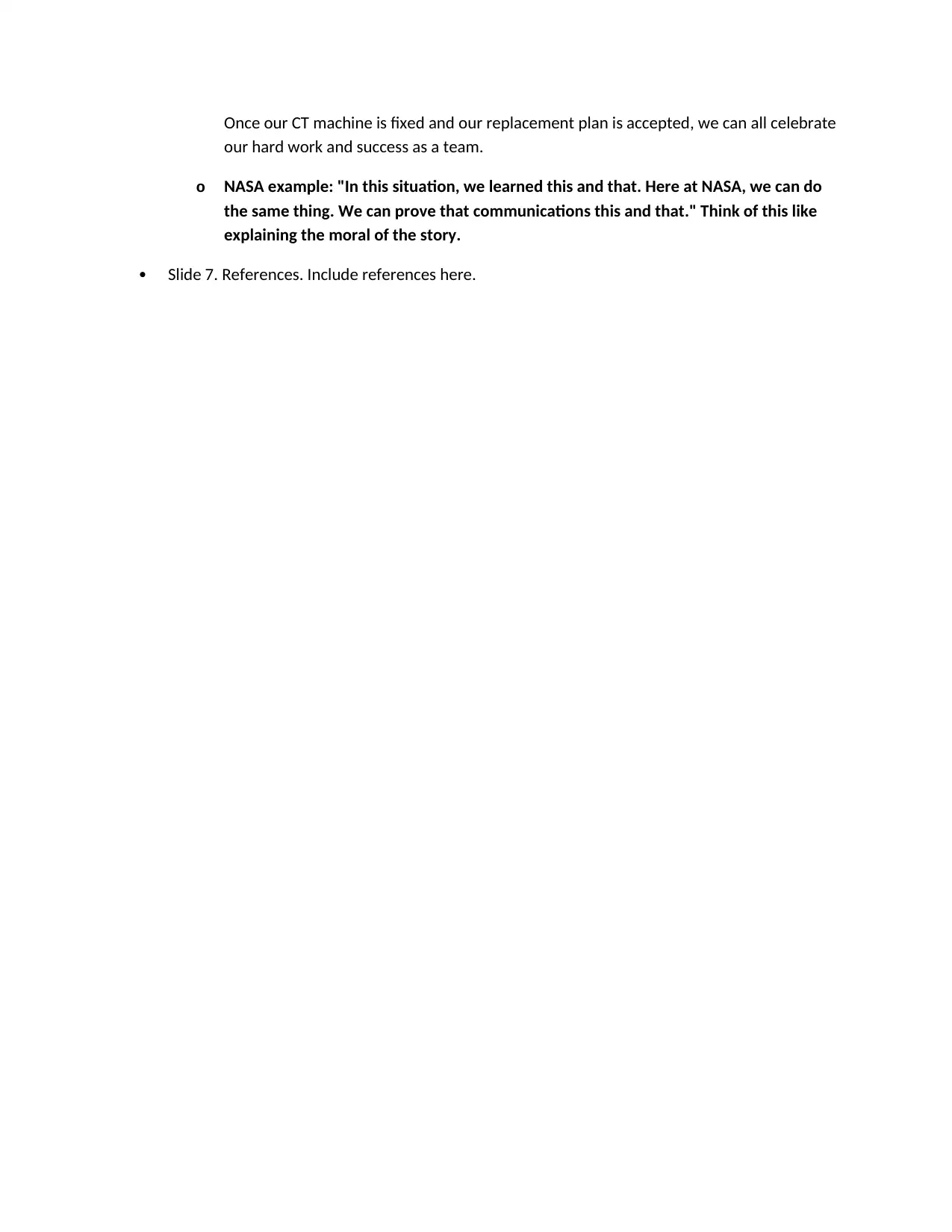
Once our CT machine is fixed and our replacement plan is accepted, we can all celebrate
our hard work and success as a team.
o NASA example: "In this situation, we learned this and that. Here at NASA, we can do
the same thing. We can prove that communications this and that." Think of this like
explaining the moral of the story.
Slide 7. References. Include references here.
our hard work and success as a team.
o NASA example: "In this situation, we learned this and that. Here at NASA, we can do
the same thing. We can prove that communications this and that." Think of this like
explaining the moral of the story.
Slide 7. References. Include references here.
1 out of 5
Your All-in-One AI-Powered Toolkit for Academic Success.
+13062052269
info@desklib.com
Available 24*7 on WhatsApp / Email
![[object Object]](/_next/static/media/star-bottom.7253800d.svg)
Unlock your academic potential
Copyright © 2020–2025 A2Z Services. All Rights Reserved. Developed and managed by ZUCOL.

